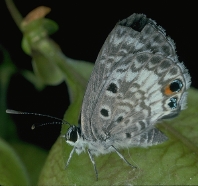Invasion, colonization, and disturbance: history and ecology of the endangered Miami Blue butterfly and a guild of subtropical seed-predators in Florida.
The beleaguered Antillean biotic community of southern-most Florida includes the Miami Blue Butterlfly, Hemiargus thomasi bethunebakeri, which is at immediate risk of extinction.
This lycaenid butterfly is now reduced to a few dozen individuals on a single islet of the Middle Florida Keys. We detail for the first time its reproductive ecology, and present a biological and historical analysis of its decline. We correct the misperception that the host plant, Balloon Vine (Cardiospermum corindum), is an exotic weed.
Between 1988 and 2003, 96% of focal host individuals disappeared, mainly due to human disturbance. Four other seed predators co-occur, including another lycaenid butterfly, the Silver-banded hairstreak, which is a recent colonist and competes with the Miami Blue. The Blue and a specialist wasp were absent from field surveys of Balloon Vine in 2003. We describe complex interactions among the seed predators and the host plant that once favored coexistence and that have been disrupted. We recommend protection of Balloon Vine and cooperative study of mosquito control impacts on terrestrial invertebrates of southern-most Florida.

